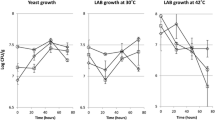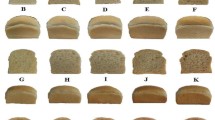Abstract
This study was conducted to investigate the effect of open and controlled fermentation on the proximate composition, mineral elements, antinutritional factors and flatulence-causing oligosaccharides in Vigna racemosa. The open fermentation was carried out using the microorganisms present in the atmosphere while the controlled fermentation was carried out using Aspergillus niger as a starter. The proximate composition of the Vigna racemosa, some anti-nutrients and the mineral elements were analyzed using standard procedures. The protein content was increased by 12.41 ± 1.73 % during open fermentation while it decreased by 29.42 ± 0.1 % during controlled fermentation. The lipids, carbohydrates, crude fibre and ash content were all reduced in both types of fermentation except the moisture content which increased in controlled fermentation. Apart from calcium, the other elements (Fe, Na, Mg, Zn, and K) suffered reduction in both types of fermentation. The phytate, tannin, alkaloids, hydrogen cyanide, lectins, trypsin inhibitors and oxalate content all had drastic reductions in both types of fermentation. Open and controlled fermentation reduced the levels of both raffinose and stachyose. The percentages of reduction due to controlled fermentation were higher than those of open fermentation in the antinutrients studied. Fermentation is an efficient method for detoxifying the antinutrients in the Vigna racemosa studied in this work.
Similar content being viewed by others
References
Adegunwa MO, Adebowale AA, Solano EO (2012) Effect of thermal processing on the Biochemical composition, antinutritional factors and functional properties of beniseeds (Sesamum indicum) flour. Am J Biochem Mol Biol 2(3):175–182
AOAC (1980) Official methods of analysis. Association of Official Analytical Chemists, Washington
AOAC (1984) Official methods of analysis. Association of Official Analytical Chemists, Washington
AOAC (1990) Official methods of analysis, 15th edn. Association of Official Analytical Chemists, Washington
Arntfield SD, Ismond MAH, Murray ED (1985) The fate of anti-nutritional factors during the preparation of faba bean protein isolates using a micellization technique. Can Inst Food Sci Technol J 18(2):137–143
Bhat TK, Makkar HP, Singh B (1997) Preliminary studies on tannin degradation by Aspergillus niger-van tieghern MTCC 2425. Lett Appl Microbiol 25:22–23
Biswas TK, Sana NK, Badal RK, Huque EM (2001) Biochemical study of some oil seeds (Brassica, Sesame and Linseed). Pak J Biol Sci 4:1002–1005
Borejszo Z, Khan K (1992) Reduction of flatulence-causing sugars high temperature extraction of pinto bean high starch fractions. J Food Sci 57:771–772
Carnovale E, Lugaro E, Marconi E (1991) Protein quality and antinutritional factors in wild and cultivated species of Vigna spp. Plant Foods Hum Nutr 41:11–20
Czarnecka M, Czarnecki Z, Nowak J, Roszyk H (1998) Effect of lactic fermentation and extrusion of bean and pea seeds on nutritional and functional properties. Nahrung 1:7–11
De Stefanis VA, Ponte JG (1968) Separation of sugars by thin layer chromatography. J Chromatogr A 36:116–120
de Vries RP, Flitter SJ, Van de Vondervoort PJ, Chaveroche M, Fontaine T, Fillinger S, Ruijter GJ, D’Enfert C, Visser J (2003) Glycerol dehydrogenase, encoded by gldB is essential forosmotolerance in Aspergillus nidulans. Mol Microbiol 49:131–141
Difo HV, Onyike E, Ameh DA, Njoku GC, Ndidi US (2013) Isolation of Aspergillus niger from three varieties of Bambara nuts for simultaneous production of phytase and tannase. J Yeast Fungal Res 4(1):1–4
Doblado R, Frias J, Muñoz R, Vidal-Valverde C (2002) Anti-nutritional factors content of dry beans (Phasealus vulgaris) as affected by fermentation. Pol J Food Nutr Sci 11(52):73–75
Ellis D (2006) Mycology on line. The University of Adelaide, Australia
Fadahunsi IF (2009) The effect of soaking, boiling and fermentation with Rhizopus oligosporus on the water soluble vitamin content of Bambara groundnut. Pak J Nutr 8(6):835–840
Granito M, Champ M, David A, Bonnet C, Guerra M (2001) Identification of gas producing components in different varieties of Phaseolus vulgaris by in vitro fermentation. J Sci Food Agric 81:543–550
James CS (1995) Analytical chemistry of foods, 1st edn. Chapman and Hall, New York, pp 1–31
Kazanas N, Fields ML (1981) Nutritional improvement of sorghum by fermentation. J Food Sci 46(3):819–821
Lucas GM, Markakas P (1975) Phytic acid and other phosphorus compounds of bean (Phaseolus vulgaris). J Agric Educ Chem 23:13–15
Madeira JV Jr, Macedo JA, Macedo GA (2011) Detoxification of castor bean residues and the simultaneous production of tannase and phytase by solid-state fermentation using Paecilomyces variotii. Bioresour Technol 102(15):7343–7348
Makkar HPS, Blümmel M, Borowy NK, Becker K (1993) Gravimetric determination of tannins and their correlations with chemical and protein precipitation methods. J Sci Food Agric 61(2):161–165
Marconi E, Ruggeri S, Carnovale E (1996) Chemical evaluation of wild under—exploited Vigna spp. Seeds. Food Chem 59:203–212
Martín-Cabrejas MA, Sanfiz B, Vidal A, Mollá E, Esteban R, López-Andréu FJ (2004) Effect of fermentation and autoclaving on dietary fibre fractions and antinutritional factors of beans (Phaseolus vulgaris). J Agric Food Chem 52(2):261–266
Ndidi US, Ndidi CU, Olagunju A, Muhammad A, Billy FG, Okpe O (2014) Proximate, antinutrients and mineral composition of raw and processed (boiled and roasted) Sphenostylis stenocarpa seeds from Southern Kaduna, North-West Nigeria. ISRN Nutr 2014:1–9
Ogun PO, Markakis P, Chenoweth W (1989) Effect of processing on certain antinutrients in cowpeas (Vigna unguiculata). J Food Sci 54(4):1084–1085
Oke OL (1969) The role of hydrocyanic acid in nutrition. World Rev Nutr Diet 11:170–198
Onwuka B (2005) Food analysis and instrumentation theory and practical. Naphtali prints, Lagos, pp 1–148
Oyewole OA, Isah P (2012) Locally fermented foods in Nigeria and their significance to national economy: a review. J Recent Adv Agric 1(4):92–102
Padulosi S, Ng NQ (1990) Wild Vigna species in Africa: Their collection and potential utilization in cowpea genetic resources. In: Ng NQ, Monti LM (eds) Cowpea genetic resources. IITA, Ibadan, pp 58–77
Pang PK, Ibrahim CO (2004) Xylanase production by a local fungal isolate, Aspergillus niger USM11 via solid state fermentation using palm kernel cake (PKC) as substrate. Songklanakarin J Sci Technol 27(2):326–336
Philips RD, McWatters KM (1991) Contribution of cowpeas to nutrition and health. Food Technol 45:127–130
Purnama IN (2004) Studies on potency of fungal isolates to cleave tannin linkage in cacao pod (Theobroma cacao L). [Thesis]. Bogor: Institut Pertanian Bogor, Indonesia
Stahl E, Kaltenbach U (1961) Dünnschicht-chromatographie: VI. Mitt Spurenanalyse G-Schichten J Chromatogr A 5:351–355
Yadav H, Jain S, Rastamanesh R, Bomba A, Catanzaro R, Marotta F (2011) Fermentation technology in the development of functional foods for human health: where we should head. Ferment Technol 1(1):e102
Zamora AF, Fields ML (1979) Sensory evaluation and nutritive value of soups and chips made from fermented and non fermented beans. J Food Sci 44(3):930–931
Author information
Authors and Affiliations
Corresponding author
Rights and permissions
About this article
Cite this article
Difo, V.H., Onyike, E., Ameh, D.A. et al. Changes in nutrient and antinutrient composition of Vigna racemosa flour in open and controlled fermentation. J Food Sci Technol 52, 6043–6048 (2015). https://doi.org/10.1007/s13197-014-1637-7
Revised:
Accepted:
Published:
Issue Date:
DOI: https://doi.org/10.1007/s13197-014-1637-7




